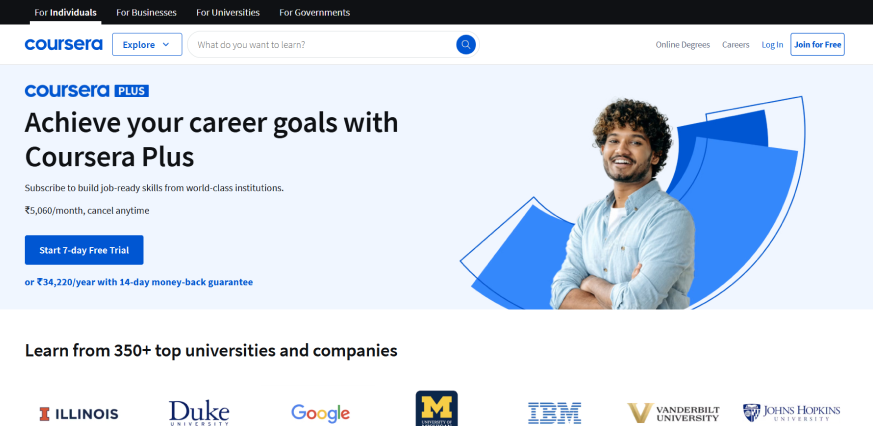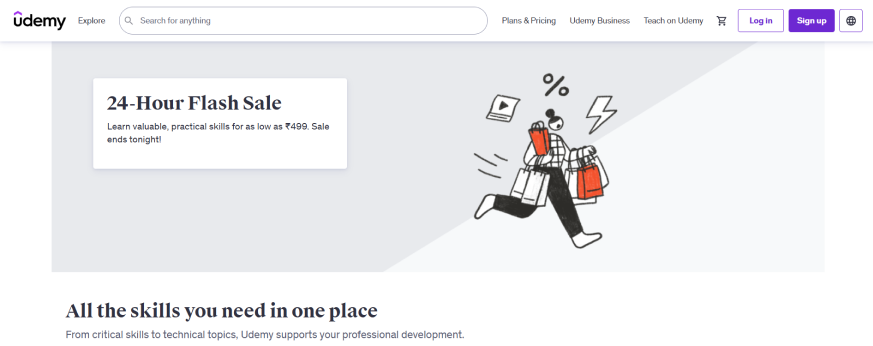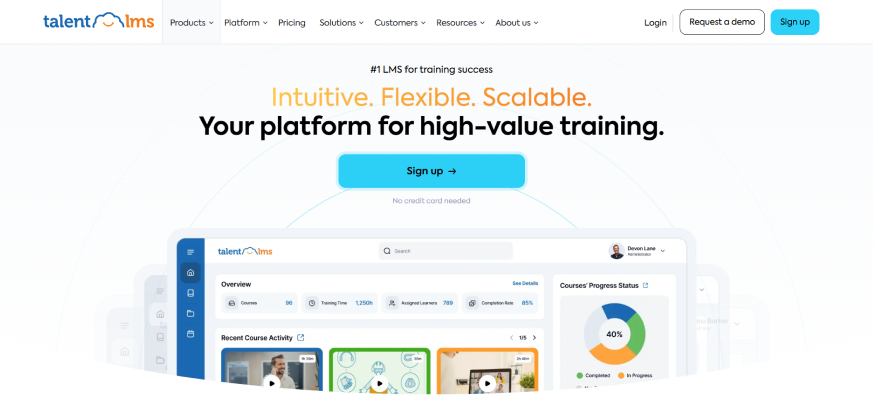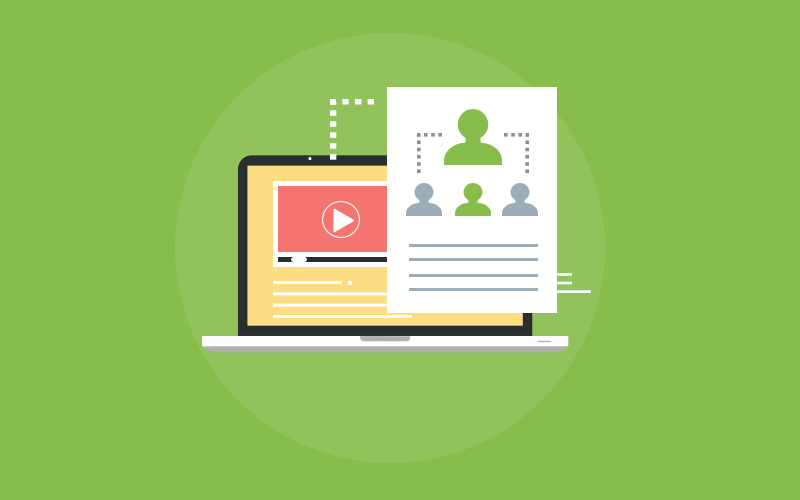Jack Welch once wisely said that an organization’s ability to learn and then translate that learning into action is the ultimate competitive advantage. And honestly, I couldn’t agree more. In today’s workplace, knowledge isn’t just power—it’s survival.
I’ve seen firsthand how companies struggle with outdated training methods—endless PowerPoints, day-long workshops, and information overload that employees forget by the following week. eLearning flips that script. Instead of disrupting workflows, it delivers training exactly when and where needed.
In this guide, I’ll break down the elearning definition, how it works, and why companies prioritize it in 2025. Let’s begin with what is elearning.
What Is eLearning?
eLearning, short for electronic learning, is all about delivering training and educational content through digital platforms, such as ProProfs Training Maker. Unlike traditional training sessions that require employees to sit in a classroom at a scheduled time, eLearning makes training available anytime, anywhere—all you need is an internet connection.
This isn’t just a convenience; it’s a game-changer for businesses. Instead of pulling employees away from work for hours-long sessions, companies can deliver training in bite-sized, engaging formats that fit into their schedules. It’s a smarter, more scalable way to upskill teams, onboard new hires, and keep employees informed without disrupting productivity.
The best part? eLearning doesn’t stop at accessibility. It allows businesses to track progress, measure engagement, and assess employee understanding in real time. Whether it’s compliance training, product knowledge, or leadership development, companies can ensure employees get the knowledge they need without the inefficiencies of traditional training.
Evolution of eLearning: From Basic to AI-Powered Solutions
eLearning has come a long way from simple online courses to becoming a fundamental part of corporate training. Once considered an alternative learning method, it is now a multi-billion-dollar industry projected to exceed $1 trillion by 2032 and has grown by 900% since its inception in 2000.
The Early Beginnings & Internet Era: eLearning wasn’t always the digital powerhouse it is today. The concept started with computer-based training (CBT) programs in the 1960s and 70s, where companies and institutions used software to deliver structured lessons. As technology evolved, so did the methods, with CD-ROM-based learning becoming popular in the 1990s.
In the early 2000s, companies began adopting Learning Management Systems (LMS) to digitize training programs. Initially, these platforms were limited to static courses and PDFs, making them more of an online reference tool than an interactive learning experience.
In the 2010s, the demand for engaging, accessible, and personalized training led to the adoption of video-based content, gamification, and mobile learning. Organizations started using data-driven insights to track learner progress and improve training effectiveness.
The Pandemic Impact: COVID-19 accelerated the adoption of eLearning across industries. The pandemic didn’t just push eLearning forward—it catapulted it into the spotlight. With in-person training off the table, businesses had no choice but to go digital, making online learning the backbone of corporate training.
Companies scrambled to adopt virtual platforms while those already using eLearning fine-tuned their strategies. Tech giants like Google and Microsoft expanded free offerings, and remote learning became the new normal.
The result? The corporate eLearning market skyrocketed past $200 billion, with no signs of slowing down. If anything, the pandemic proved that digital learning isn’t just an option anymore—it’s essential.
Modern Advancements (Post 2010s and the Pandemic): The post-pandemic shift to eLearning has driven major advancements in corporate training:
- Gamification: Turning training modules into interactive experiences, gamification uses game mechanics to make learning engaging and effective. Employees are more motivated to complete courses that feel like games rather than chores.
- Micro-learning: It recognizes that attention spans are short. It delivers content in bite-sized chunks, allowing employees to grasp complex topics quickly and retain information more effectively.
- Mobile Learning: With the rise of remote work, accessible training on mobile devices ensures employees can learn anytime, anywhere. This flexibility is crucial for maintaining productivity and engagement.
- Video-Based Learning: Incorporating videos into training materials caters to visual learners and breaks complex concepts into digestible formats. It’s a dynamic way to keep employees engaged and informed.
Businesses now leverage corporate eLearning solutions, saving millions in training costs while boosting productivity. Almost half of the Fortune 500 companies have embraced eLearning, with IBM alone saving $200 million after making the switch.
Future Trends: Virtual reality (VR), augmented reality (AR), and AI-powered adaptive learning will shape the next wave of corporate learning. Thanks to the increasing use of AI in adaptive learning, there might be a $12.5 billion market for personalized e-learning by 2027, making immersive learning experiences the next frontier. Companies investing in these innovations will stay ahead and build smarter, more adaptable workforces.
The evolution of elearning is an ongoing process caused by continuous technological advancements and a growing understanding of how people learn best. As technology is evolving, we can expect elearning to become even more personalized, immersive, and effective in meeting the diverse needs of learners worldwide.
As companies scale and evolve, eLearning will become a necessity rather than a luxury. It’s not just about cutting costs—it’s about creating a more innovative and agile workforce equipped to handle whatever comes next.
Different Types of eLearning Platforms
Businesses today have no shortage of eLearning platforms, each catering to different training needs—be it for onboarding new employees, upskilling teams, or ensuring compliance. Choosing the right platform depends on how your organization delivers training and what learning experience you want to create. I have compiled a list of the most common types:
LMS
An LMS is the backbone of corporate training. It centralizes learning materials, tracks progress, and automates reporting. No matter if you’re onboarding new hires or delivering ongoing training, an LMS keeps everything organized and scalable.
Micro-learning Platforms
Short, focused lessons work better than long, drawn-out courses—especially for busy employees. Micro-learning platforms deliver bite-sized content through videos, quizzes, and interactive modules, making it easier to learn and apply new skills on the go.
Virtual Instructor-Led Training (VILT) Platforms
Some training works best with a human touch. VILT platforms bring live instructors into the mix, allowing businesses to host real-time training sessions with features like breakout rooms, live Q&As, and collaborative exercises. It’s a great way to keep remote teams engaged without losing the benefits of traditional classroom training.
Employee Training Platforms
Designed specifically for workforce learning, these platforms help companies structure training programs with built-in learning paths, AI-driven recommendations, and interactive assessments. They focus on skill development, leadership training, and professional growth.
Compliance Training Platforms
Industries with strict regulations—like healthcare, finance, or manufacturing—need a way to ensure employees meet compliance requirements. Compliance training platforms track mandatory certifications, ensure employees complete required training on time, and generate reports for audits.
Course Marketplaces
Sometimes, businesses don’t need to build training programs from scratch. Platforms like LinkedIn Learning, Coursera, and Udemy offer pre-built courses on everything from technical to soft skills. Employees can learn at their pace conveniently, and businesses can tap into a massive library of expert-led content.
Gamified Learning Platforms
Engagement skyrockets when learning feels like a game. Gamified learning platforms use leaderboards, points, and rewards to make training more interactive and fun. These work particularly well for sales training, customer service programs, and any scenario where motivation plays a big role.
Mobile Learning Platforms
With more employees working remotely or on the move, mobile-first learning platforms ensure training is accessible anytime, anywhere. Employees can complete courses, watch videos, or take quick assessments from their phones—without being tied to a desk.
Adaptive Learning Platforms
Not everyone learns at the same pace, and that’s where adaptive learning platforms shine. These use AI to personalize training based on each employee’s progress, strengths, and weaknesses, ensuring they get the most relevant content at the right time.
Social Learning Platforms
Learning doesn’t always have to be a solo activity. Social learning platforms encourage peer-to-peer collaboration through discussion boards, team-based challenges, and knowledge-sharing communities. They’re ideal for fostering a culture of continuous learning and mentorship.
eLearning Platforms: My Top 5 Picks
1. ProProfs Training Maker
ProProfs Training Maker is a cloud learning management system (LMS) designed to create, deliver, and track online training courses. It offers course authoring, quizzes, assessments, learning paths, and reporting.
Best for: Online training courses, employee onboarding, compliance training, and knowledge management.
What You Will Like:
- Prebuilt, customizable & ready-to-use courses taught by experts.
- Wide range of assessment options, including quizzes, surveys, and polls.
- Learning paths and personalized learning experiences.
- Powerful reporting and analytics to track learner progress.
- Integrations with other business tools.
- Competitive pricing plans.
What You May Not Like:
- A dark user user interface mode is not yet available.
- Unlike the paid plan, there is no dedicated manager for the free plan.
Price:
Starts at $1.99/learner/month. Forever-free version available with all premium features.
2. Docebo

Docebo is an AI-powered learning platform designed for enterprises focusing on personalized learning experiences. It offers features like social learning, content curation, gamification, and advanced analytics, aiming to create a more collaborative and effective learning environment for employees.
Best for: Personalized enterprise training
What You Will Like:
- AI-powered personalization and recommendations.
- Social learning features to encourage collaboration.
- Content curation and learning playlists.
- Gamification to boost engagement.
- Advanced analytics and reporting.
What You May Not Like:
- Can be more complex to set up and manage than simpler LMSs.
- Pricing can be higher for smaller organizations.
Price:
Custom pricing.
3. Coursera

Coursera collaborates with organizations and universities worldwide to offer a vast library of online courses, specializations, and degrees. It offers a learning platform for individuals to gain new skills, take their careers forwards, and pursue higher education.
Best for: Professional development, higher education, and supplementing corporate training programs with a wide range of content.
What You Will Like:
- A vast library of high-quality courses from top universities and organizations.
- Variety of learning formats, including video lectures, readings, quizzes, and projects.
- Flexible learning schedules to accommodate different needs.
- Affordable pricing for individual learners.
- Coursera for Business offers curated content and features for organizations.
What You May Not Like:
- Limited customization and branding options for corporate training.
- May lack robust administrative tools for managing large-scale training programs.
Price:
Coursera for Business costs $399/user/year.
4. Udemy

Udemy is an elearning marketplace that offers a massive library of courses taught by independent instructors. It covers various topics, including technology, business, design, and personal development.
Best for: Skill development and supplementing corporate training with various topics and instructors.
What You Will Like:
- Huge selection of courses on diverse topics.
- Affordable pricing for individual courses.
- Lifetime access to purchased courses.
- Udemy for Business offers curated content and features for organizations.
What You May Not Like:
- Course quality varies depending on the instructor.
- Limited customization and branding options for corporate training.
Price:
Starts at $35/month.
5. TalentLMS

TalentLMS is a cloud-based LMS known for its ease of use and quick setup. It offers course creation, assessments, learning paths, and reporting. It aims to simplify the training process and make it accessible to organizations of all sizes.
Best for: Keeping their pricing in mind, this is suitable for large to enterprise users
What You Will Like:
- Fast setup and deployment.
- Affordable pricing plans.
- Good range of features for most training needs.
- Bite-sized courses in their library
What You May Not Like:
- The interface isn’t that intuitive, with so many buttons to click
- Customization options are limited.
- It might not be suitable for very large enterprises with complex training requirements.
Price:
Their most popular pricing, “Pro” starts at $601 /month with the talent-library add-on
Get Free eLearning Authoring Software — All Features, Forever.
We've helped 567 companies train 200,000+ employees. Create courses in under a minute with our AI LMS or use 200+ ready-made courses on compliance, harassment, DEI, onboarding, and more!
How Does eLearning Work?
eLearning connects learners and instructors through an intuitive digital platform, making training more structured, interactive, and accessible.
- Once learners enroll in a course, they get access to a personalized dashboard to explore lessons, track progress, and engage with different types of content. Whether it’s self-paced modules, live instructor-led sessions, or interactive exercises, the experience is designed to be flexible and engaging.
- For learners, eLearning provides a structured yet adaptable way to acquire new skills. They can watch video lessons, participate in discussions, complete quizzes, and submit assignments—all from their preferred device. Many platforms offer certifications upon completion, making learning more goal-driven and rewarding.
- Instructors use the platform to create, manage, and monitor training programs. They upload materials, conduct live sessions, track learner performance, and provide personalized feedback. Automated features help streamline course assignments, send reminders, and generate reports, ensuring trainers and learners stay on track.
- Beyond just delivering content, eLearning platforms foster engagement through real-time interactions, community discussions, and collaborative projects. Integrating AI-driven analytics also helps instructors fine-tune courses based on learner behavior, ensuring continuous improvement in training effectiveness.
Advantages of eLearning: How It Benefits Different Audiences
eLearning isn’t just another way to deliver training—it directly impacts how people learn, teach, and grow. There are numerous benefits of elearning. I’ve mentioned some of them here for you:
For Employees: Flexible Learning That Fits Their Schedule
Traditional training sessions don’t always work for employees juggling deadlines and daily tasks. With eLearning, employees can go through lessons whenever it suits them—on a break, after work, or even during a slow day. There is no need to sit through hours of in-person lectures; they can pause, rewind, and go at their own pace.
More than convenience, eLearning supports long-term career growth. Employees can upskill without taking time off, access industry-specific training, and stay ahead in their roles. Companies that invest in structured learning see better engagement and a more skilled workforce.
For Trainers & Educators: Consistency, Better Engagement, and Real-Time Tracking
Delivering the same training across different teams, locations, or time zones is a challenge. eLearning keeps it consistent. Once a course is built, every learner gets the same material, reducing the risk of mixed messages or knowledge gaps.
Engagement is another advantage. Instead of lecturing, trainers can use interactive lessons, quizzes, and discussion forums to keep learners involved. They also get real-time data on progress—who is completing courses, where people struggle, and what needs improvement.
For Businesses: Cost Savings and Scalable Training
Companies spend thousands on travel, venues, and instructor-led training. eLearning cuts these costs while keeping the training just as effective. IBM saved $200 million by switching to eLearning—proof that businesses benefit from making training accessible online.
It’s also easy to scale. Whether onboarding a handful of new hires or rolling out compliance training to thousands of employees worldwide, eLearning removes logistical headaches. Plus, tracking tools let businesses see precisely how training impacts performance so adjustments can be made as needed.
Real-World Applications of eLearning Across Industries
eLearning is making a real difference across all industries (and not just education) with all its unconventional use cases. Here, I’ve mentioned some of them for you:
Employee Training & Development
- Onboarding Without the Hassle: Instead of overwhelming new hires with paperwork and in-person sessions, companies deliver structured, self-paced eLearning courses.
- Compliance Training That Sticks: Industries with strict regulations, such as finance, healthcare, and manufacturing, use eLearning to keep employees updated on safety, security, and legal requirements without taking them away from work for long periods.
- Upskilling & Career Growth: Businesses invest in leadership training, soft skills development, and technical certifications through eLearning to keep employees engaged and ready for new challenges.
Healthcare & Medical Training
- Training Without Taking Time Away from Patients: Doctors, nurses, and healthcare staff use eLearning to stay updated on medical advancements and best practices without stepping away from their duties.
- Better Patient Education: Healthcare providers offer eLearning modules to help patients understand treatment plans, manage chronic conditions, and improve overall health.
- Regulatory & Safety Compliance: With ever-changing healthcare regulations, eLearning efficiently ensures hospital staff complies with the latest protocols.
Finance, IT & Manufacturing
- Financial Training on Demand: Banks and financial institutions use eLearning for fraud detection, risk management, and compliance training to keep employees informed without endless meetings.
- IT & Software Development Training: Tech professionals use eLearning to master new coding languages, cybersecurity protocols, and cloud technologies without leaving their desks.
- Manufacturing & Safety Training That Works: eLearning allows employees to receive interactive safety training and equipment handling lessons, reducing accidents and downtime.
Retail, Hospitality & Customer Service
- Retail Training Without Interrupting Sales: Store employees use eLearning to sharpen product knowledge, improve customer interactions, and boost sales performance—without stepping away from customers for hours.
- Hospitality Training That Scales: Hotels, airlines, and travel agencies use eLearning to train staff on booking systems, customer service, and safety protocols across multiple locations.
- Customer Service That Helps: Call centers and support teams use eLearning to refine communication skills, handle customer issues effectively, and provide better overall service.
Companies That Are Winning With eLearning
Some of the biggest brands in the world have saved millions by switching to eLearning.
- IBM: Saved $200 million by ditching traditional training methods in favor of eLearning.
- Dow Chemicals: Cut $34 million in training costs with eLearning programs.
- Google: Uses eLearning to train employees in leadership, technical skills, and workplace policies.
- Amazon: Delivers eLearning courses to enhance employee customer service, logistics, and operations expertise.
Common eLearning Challenges & How to Overcome Them
eLearning is an amazing tool for training and development, but it’s not without its challenges. From low engagement to tech issues, businesses often run into roadblocks when rolling out eLearning programs. The good news? Every challenge has a solution. Here’s a look at the most common eLearning hurdles and how to tackle them.
Low Engagement & Motivation
Not everyone is thrilled about online training—some employees see it as just another task to complete rather than a valuable learning opportunity.
Solution:
- Make it interactive with videos, quizzes, and gamification to keep learners engaged.
- Offer bite-sized modules (micro-learning) so training doesn’t feel overwhelming.
- Communicate why the training matters—tie it to real-world job benefits and career growth.
| Pro Tip: With ProProfs Training Maker, you can create highly interactive courses with quizzes, multimedia, and certifications to keep learners engaged. |
Lack of Technical Skills
Not all employees are comfortable with elearning platforms, especially in industries where traditional training has been the norm.
Solution:
- Choose an intuitive eLearning platform with a clean, user-friendly interface like ProProfs Training Makerx.
- Provide a simple orientation or tutorial before rolling out a new course.
- Offer technical support or a help desk to assist employees who run into issues.
Information Overload
A long, dense eLearning course can be just as ineffective as a boring lecture. Too much information at once leads to cognitive overload, making it hard for employees to retain what they learn.
Solution:
- Break down courses into shorter, digestible lessons.
- Use real-world scenarios and use-cases to make learning more practical.
- Reinforce key concepts with follow-up assessments and refreshers.
Lack of Personalization
A one-size-fits-all training program doesn’t work for everyone. Employees have different learning paces, knowledge levels, and job roles.
Solution:
- Offer adaptive learning paths that adjust based on learner progress.
- Allow employees to choose elective courses based on their role and interests.
- Use AI-driven recommendations to suggest relevant content based on past performance.
Poor Retention & Application of Knowledge
Just because employees complete a course doesn’t mean they’ll remember or apply what they learned.
Solution:
- Implement scenario-based learning where employees solve real problems.
- Use spaced repetition—schedule refresher lessons and quizzes over time.
- Encourage on-the-job application by pairing eLearning with hands-on practice.
Limited Interaction & Isolation
Traditional in-person training fosters discussions and teamwork, which can be missing in an eLearning environment.
Solution:
- Incorporate live webinars, discussion forums, and peer reviews to encourage interaction.
- Offer collaborative projects where employees work together on assignments.
- Assign mentors or learning buddies to keep learners engaged and accountable.
| Pro Tip: With tools like ProProfs Training Maker, you can integrate quizzes, feedback loops, and collaborative tools to keep employees engaged and connected. |
Technical Issues & Compatibility Problems
Slow-loading content, platform crashes, or courses that don’t work on mobile devices can derail learning.
Solution:
- Choose a cloud-based LMS that’s reliable and regularly updated.
- Ensure the platform is mobile-friendly so employees can learn on any device.
- Conduct regular system tests to identify and fix technical glitches before they become significant issues.
Get Free eLearning Authoring Software — All Features, Forever.
We've helped 567 companies train 200,000+ employees. Create courses in under a minute with our AI LMS or use 200+ ready-made courses on compliance, harassment, DEI, onboarding, and more!
How to Create an eLearning Program
Creating an eLearning program doesn’t have to be complicated. I’ve used many platforms, but with ProProfs Training Maker, you can design and launch engaging online courses with ease. Here’s how:
Step 1: Choose Your Course Type
- Browse the ProProfs course library for customizable courses on compliance, leadership, employee skills, and more.
OR
- Click “Create a Course” on the dashboard and build a training program tailored to your needs.
You can also create online courses in minutes with the help of ProProfs AI course creator. Learn more here.
Step 2: Customize Course Content
- Add a title, description, and cover image, and adjust the colors and button text to match your branding.
- Upload videos, PDFs, slideshows, and quizzes to create an engaging learning experience.
- Save time with pre-designed templates for structured course content.
- If needed, add instructors with their profiles to enhance the learning experience.
Step 3: Incorporate Assessments & Quizzes
- Add interactive quizzes, surveys, and polls to test learner comprehension.
- Enable automatic grading and feedback to streamline evaluation.
Step 4: Preview & Publish
- Review your course using the preview feature to ensure everything looks perfect.
- Click “Publish” to make it available for learners.
Step 5: Track & Analyze Progress
- Use real-time reports to monitor learner progress, completion rates, and performance.
- Identify knowledge gaps and make improvements to enhance effectiveness.
Transforming Workplace Learning for Good
eLearning is no longer just about delivering online courses—it’s about creating engaging, flexible, and results-driven learning experiences that help businesses grow and employees thrive.
While challenges like engagement, personalization, and technical issues exist, the right strategies and platforms—like ProProfs Training Maker—can make eLearning more effective, accessible, and impactful.
As the corporate eLearning market expands, companies embracing digital learning will gain a competitive edge. The future of workplace learning is digital, and businesses that invest in the right tools today will set themselves up for success tomorrow.
Frequently Asked Questions
What is the difference between custom and off-the-shelf eLearning?
Choosing between custom and off-the-shelf eLearning depends mainly on your organization’s specific needs and budget. Custom eLearning involves creating tailored courses for your unique objectives, content, and branding. This offers maximum flexibility and control over the learning experience but typically comes with a higher price tag and longer development time.
On the other hand, Off-the-shelf eLearning provides ready-made courses that are available for immediate use. This is a more cost-effective and faster solution, but the content may not perfectly align with your specific requirements or branding.
How is eLearning different from similar terms like online learning or digital learning?
eLearning: A broader term encompassing all forms of electronic learning, including online courses, webinars, simulations, and mobile learning.
Online Learning: Learning that happens over the Internet, often through web-based platforms. A subset of eLearning.
Digital Learning: Any learning that uses digital technologies, including eLearning, also encompasses tools like videos, podcasts, and interactive simulations.
What is the difference between synchronous and asynchronous eLearning?
The distinction between synchronous and asynchronous eLearning lies in the timing of the interaction. Synchronous eLearning involves real-time interaction between learners and instructors, such as live webinars or virtual classrooms. This allows for immediate feedback and discussion but requires everyone to be present simultaneously.
On the other hand, Asynchronous eLearning occurs at the learner’s pace, without real-time interaction. This offers greater flexibility and convenience, as learners can access courses/learning material whenever and wherever they choose.
What factors influence the cost of eLearning development?
The cost of eLearning development can vary significantly depending on several factors:
Content complexity: The more complex the content, the more expensive it will be to develop.
Multimedia elements: Using high-quality visuals, animations, and videos increases costs.
Interactivity: Interactive elements and simulations add to development expenses.
Learning platform: The choice of LMS or eLearning platform can affect costs.
Development time: Longer development timelines generally mean higher costs.
Instructional design: Experienced instructional designers command higher fees.
Subject matter expertise: Engaging subject matter experts can add to costs.
Maintenance and updates: Ongoing maintenance and updates incur additional expenses.
 Tips
Tips
We’d love to hear your tips & suggestions on this article!
Get Free eLearning Authoring Software — All Features, Forever.
We've helped 567 companies train 200,000+ employees. Create courses in under a minute with our AI LMS or use 200+ ready-made courses on compliance, harassment, DEI, onboarding, and more!

 We'd love your feedback!
We'd love your feedback! Thanks for your feedback!
Thanks for your feedback!







